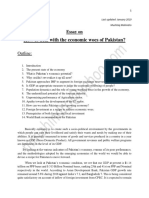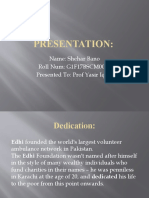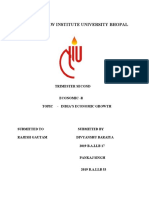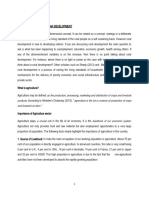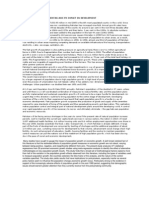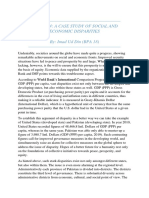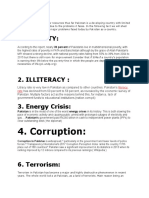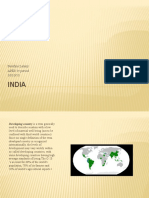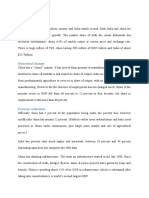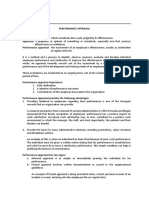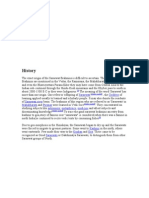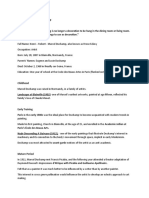DR
DR
Uploaded by
mabdullah_asad9813Copyright:
Available Formats
DR
DR
Uploaded by
mabdullah_asad9813Original Title
Copyright
Available Formats
Share this document
Did you find this document useful?
Is this content inappropriate?
Copyright:
Available Formats
DR
DR
Uploaded by
mabdullah_asad9813Copyright:
Available Formats
Dr.
Ishrat Husain, a former World Bank senior official and an ex governor of the State Bank of Pakistan, wrote an article captioned "India, Pakistan: a comparison" at the end of the first five decades of two nations' existence as independent states. To my knowledge, Dr. Hussain has not done an update of his article since it was first published. Although about three years too late, this post is my attempt to present a comparison of the two South Asian nations after sixty years of independence. Here is the opening paragraph from Dr. Husain's article from the late 1990s, which I believe still stands true today: "India and Pakistan are completing five decades of their independence. Since the partition, the relationship between the two countries has been uneasy and characterized by a set of paradoxes. There is a mixture of love and hate, a tinge of envy and admiration, bouts of paranoia and longing for cooperation, and a fierce rivalry but a sense of proximity, too. The heavy emotional overtones have made it difficult to sift the facts from the myths and make an objective assessment. There are in fact only two extreme types of reactions on each side. Either there are those who always find that the grass is greener on the other side of the pasture or those who are totally dismissive of the accomplishments of the other side." Not much has changed in the last ten years as far as the above paragraph is concerned. The relationship between the two nations remains as emotionally charged as ever. Then Dr. Husain's essay talked about what he saw as the common successes of the two nations in the first fifty years: 1. Despite the prophets of gloom and doom on both sides of the fence, both India and Pakistan have succeeded in more than doubling their per capita incomes. This is a remarkable feat considering that the population has increased fourfold in case of Pakistan and threefold in India. Leaving aside the countries in East Asia and China, very few large countries have been able to reach this milestone. 2. The incidence of poverty (defined as $1 per day) has also been reduced significantly although the number of absolute poor remains astoundingly high. However, the level of poverty is lower in Pakistan. 3. Food production has not only kept pace with the rise in population but has surpassed it. Both countries, leaving aside annual fluctuations due to weather conditions, are selfsufficient in food. (Pakistan exports its surplus rice but imports small volumes of wheat). 4. Food self-sufficiency has been accompanied by improved nutritional status. Daily caloric and protein intake per capita has risen by almost one-third but malnourishment among children is still high. 5. The cracks in the dualistic nature of the economy -- a well-developed modern sector and a backward traditional sector -- are appearing fast in both the countries. A buoyant middle class is emerging. The use of modern inputs and mechanization of agriculture has been a leveling influence in this direction. But public policies have not always been consistent or supportive. Here is the update to the above assessment: 1. Per capita incomes in both nations have more than doubled in the last ten years, in spite of significant increases in population. The most recent and detailed real per capita income
data was calculated and reported by Asian Development Bank based on a detailed study of a list of around 800 household and nonhousehold products in 2005 and early 2006 to compare real purchasing power for ADB's trans-national income comparison program (ICP). The ABD ICP concluded that Pakistan had the highest per capita income at HK$ 13,528 (US $1,745) among the largest nations in South Asia. ADB reported Indias per capita as HK $12,090 (US $1,560). Nominal per capita GDP estimates for Pakistan range from US $1000 to US $1022, while the range for India is from US $ 1017 to US $ 1100. Purchasing power parity (PPP) pe r capita GDP estimates for Pakistan from various sources range from $2500 to $2644, while the same sources put the range for India's per capita GDP from $2780 to $2972. 2. The incidence of poverty (defined as $1.25 per day) has also come down in both nations, although the number of poor in South Asia still remains very high. According to the 200 9 UN Human and Income Poverty Report, the people living under $1.25 a day in India is 41.6 percent, about twice as much as Pakistan's 22.6 percent. The most recent estimates by UNDP in Pakistan for 2007-2008 indicate poverty level at 17.2%.
3. Food production has barely kept pace with the rise of population, particularly in Pakistan. There have been higher food prices and shortages of various commodities such as wheat and sugar. There is widespread hunger and malnutrition in all parts of India. India ranks 66th on the 2008 Global Hunger Index of 88 countries while Pakistan is slightly better at 61 and Bangladesh slightly worse at 70. The first India State Hunger Index (Ishi) report in 2008 found that Madhya Pradesh had the most severe level of hunger in India, comparable to Chad and Ethiopia. Four states Punjab, Kerala, Haryana and Assam fell in the 'serious' category. "Affluent" Gujarat, 13th on the Indian list is below Haiti, ranked 69. The authors said India's poor performance was primarily due to its relatively high levels of child malnutrition and under-nourishment resulting from calorie deficient diets. 4. Though the nutritional status has improved in both nations, there are still very high levels of malnutrition, particularly among children. In spite of the fact that there is about 22% malnutrition in Pakistan and the child malnutrition being much higher at 40% (versusIndia's 46%), the average per capita calorie intake of about 2500 calories is within normal range. But the nutritional balance necessary for good health appears to be lacking in Pakistanis' dietar y habits. Senior Indian official Syeda Hameed has acknowledged that Pakistan and Bangladesh have done better than India in meeting the nutritional needs of their populations. 5. India's economy has grown more rapidly than Pakistan's in the last ten years. However, both nations have accepted and implemented significant economic reforms that have opened up their economies and brought about rapid growth, more than doubling the size of each economy in the last ten years. Dr. Husain's paper went on to talk about the common failures of the two countries in their first fifty years as follows: The relatively inward-looking economic policies and high protection to domestic industry did not allow them to reap the benefits of integration with the fast-expanding and much larger world economy. This has changed particularly since 1991 but the control mind-set of the politicians and the bureaucrats has not changed. The centrally planned allocation of resources and "license raj" has given rise to an inefficient private sector that thrive more on contacts, bribes, loans from public financial institutions, lobbying, tax evasion and rent-
seeking rather than on competitive behavior. Unless both the control mind-set of the government and the parasitic behavior of the private industrial entrepreneurs do not change drastically, the potential of an efficient economy would be hard to achieve. This can be accomplished by promoting domestic and international competition, reducing tariff and nontariff barriers and removing constraints to entry for newcomers. The weaknesses in governance in the legal and judicial system, poor enforcement of private property rights and contracts, preponderance of discretionary government rules and regulations and lack of transparency in decision making act as brakes on broad-based participation and sharing of benefits by the majority of the population. In terms of fiscal management, the record of both the countries is less than stellar. Higher fiscal deficits averaging 7-8 percent of GDP have persisted for fairly long periods of time and crowded out private capital formation through large domestic borrowing. Defense expenditures and internal debt servicing continue to pre-empt large proportion of tax revenues with adverse consequences for maintenance and expansion of physical infrastructure, basic social services and other essential services that only the government can provide. The congested urban services such as water, electricity, transport in both countries are a potential source of social upheaval. The state of financial sector in both countries is plagued with serious ills. The nationalization of commercial banking services, the neglect of credit quality in allocation decisions, lack of competition and inadequate prudential regulations and supervision have put the system under severe pressure and increased the share of non-performing assets in the banks portfolio. The financial intermediation role in mobilizing and efficiently allocating domestic savings has been seriously compromised and the banking system is fragile. Both countries are now taking steps to liberalize the financial sector and open it up to competition from foreign banks as well as private banks. Here is the update on the areas of common failures of India and Pakistan: Though the level of globalization of the two nations remains well below China's, both India and Pakistan have made significant strides in this direction. In Pakistan, exports account for less than 15% of gross domestic product, compared with about 25% in India and 40% in China, according former Musharraf economic adviser Salman Shah. The policy changes in both nations have also opened up greater FDI inflows, though Pakistan's FDI has declined in the last two years due to security perceptions, after several years of strong FDI inflows, particularly in banking, telecommunications, real estate and oil and gas sectors. Both countries continue to run large budget deficits. India's fiscal deficit for 2008-2009 stood at 6.5 percent of gdp and it is rising, according to Bloomberg. Pakistan has said its fiscal deficit will widen to as much as 4.9% of gross domestic product in 2009-2010, according to the Wall Street Journal. The banking sectors in both nations have seen major improvements in delivery of new services. India and Pakistan have ranked 31 and 34 respectively, out of 52 countries in the World Economic Forum's first Financial Development Report. Both nations are ranked ahead of the Russian Federation (35), Indonesia (38), Turkey (39), Poland (41), Brazil (40), Philippines (48) and Kazakhstan (45). Consumer and commercial credit availability and retail services have improved in the last ten years. Microfinance sectors are now well established in South Asia, helping fight poverty, and empowering women economically.
Both nations are suffering from poor governance resulting in lack of responsiveness to the basic needs of the vast majority of their people. In fact, the latest Human Development Report for 2009 shows that both major South Asian nations have slipped further down relative to other regions of the world. Pakistan's HDI ranking dropped 3 places from 138 last year to 141 this year, and India slipped six places from 128 in 2008 to 134 this year. The level of u rbanization in Pakistan is now the highest in South Asia, and its urban population is likely to equal its rural population by 2030, according to a report titled Life in the City: Pakistan in Focus, released by the United Nations Population Fund. Pakistan ranks 163 and India at 174 on a list of over 200 countries compiled by Nationmaste r. The urban population now contributes about three quarters of Pakistan's gross domestic product and almost all of the government revenue. The industrial sector contributes over 27% of the GDP, higher than the 19% contributed by agriculture, with services accounting for the rest of the GDP. The increasing urbanization has had the effect of defusing the "population bomb" in Pakistan. With increasing urbanization, Pakistan's population growth rate has declined from 2.17% in 2000 to 1.9% in 2008. Based on PAI Research Commentary by Karen Hardee and Elizabeth Leahy, the total fertility rate (TFR) in Pakistan is still the highest in South Asia at 4.1 children per woman. Women in urban areas have an average of 3.3 children compared to their rural counterparts, who have an average of 4.5 children. The overall fertility rate has been cut in half from about 8 children per woman in 1960s to about 4 this decade, according to a stud y published in 2009. Third, Dr. Husain turned his attention to the areas where India surpassed Pakistan: There is little doubt that the scientific and technological manpower and research and development institutions in India are far superior and can match those of the western institutions. The real breakthrough in the Indian export of software after the opening up of the economy in 1991 attests to the validity of the proposition that human capital formation accompanied by market-friendly economic policies can lift the developing countries out of low-level equilibrium trap. Indian scientists working in India excel in the areas of defense technology, space research, electronics and avionics, genetics, telecommunications, etc. The number of Ph.Ds produced by India in science and engineering every year -- about 5,000 -- is higher than the entire stock of Ph.Ds in Pakistan. The premier research institutions in Pakistan started about the same time as India have become hotbed of internal bickerings and rivalries rather than generator of ideas, processes and products. Related to this superior performance in the field of scientific research and technological development is the better record of investment in education by India. The adult literacy rate, female literacy rate, gross enrollment ratios at all levels, and education index of India have moved way ahead of Pakistan. Rapid decline in total fertility rates in India has reduced population growth rate to 1.8 percent compared to 3.0 percent for Pakistan. Health access to the population and infant mortality rates are also better in India and thus the overall picture of social indicators, although not very impressive by international standards, emerges more favorable. The two most important determinants of Pakistans dismal performance in social development are its inability to control population growth and the lack of willingness to educate girls in the rural areas.
Here's the update on areas where India was ahead of Pakistan ten years ago: In response to the growing concerns about the nation lagging in higher education achievement, Pakistan launched Hi gher Education Reform led by Dr. Ata ur Rahman, adviser to President Musharraf in 2002. This reform resulted in over fivefold increase in public funding for universities, with a special emphasis on science, technology and engineering. The reform supported initiatives such as a free national digital library and highspeed Internet access for universities as well as new scholarships enabling more than 2,000 students to study abroad for PhDs with incentives to return to Pakistan afterward. The years of reform have coincided with increases in the number of Pakistani authors publishing in research journals, especially in mathematics and engineering, as well as boosting the impact of their research outside Pakistan.
Although India has about 270 million illiterate adults, India's overall literacy rate is better than Pakistan's. Pakistan's population of illiterate adults is estimated at 47 million, fourth largest after India's 270 million, China's 71 million, Bangladesh's 49 million, according to the latest UNESCO Education For All report for 2010. But India remains significantly ahead of Pakistan in higher education, with six universities, mostly IITs, ranked among the top 400 universities of the world versus only one from Pakistan, National University of Science and Technology(NUST) ranked at 350, up from 375 last year. Replication of NUST campuses, like the IIT campuses in India, can help spawn more highly rated institutions of higher learning near major cities in Pakistan. Pakistan's info rmation technology industry is quite young. It is in very early stages of development compared to the much older and bigger Indian IT industry, which had a significant headstart of at least a decade over Pakistan. During the lost decade of the 1990s under Bhutto and Sharif governments, Pakistani economy stagnated and its IT industry did not make any headway. However, the industry has grown at 40% CAGR during the 20012007, and it is estimated at $2.8 billion as of last year, with about half of it coming from exports. This pales in comparison to over $5 billion revenue a year reported by India's Tata Consulting alone. India's literacy rate of 61% is well ahead of Pakistan's 50% rate. In higher education, six Indian universities have made the list of the top 400 universities published by Times Higher Education Supplement this year. Only one Pakistani university was considered worthy of such honor. Pakistan has consistently scored lower on the HDI sub-index on education than its overall HDI index. It is obvious from the UNDP report and other sources that Pakistan's dismal record in enrolling and educating its young people, pa rticularly girls, stands in the way of any significant positive development in the nation. The recent announcement of a new education policy that calls for more than doubling the education spending from about 3% to 7% of GDP is a step in the right direction. However, money alone will not solve the deepseated problems of poor access to education, rampant corruption and the ghost schoolsthat only exist on paper, that have simply lined the pockets of corrupt politicians and officials. Any additional money allocated must be part of a broader push for transparent and effective delivery of useful education to save the people from the curses of poverty, ignorance and extremism which are seriously hurting the nation.
A basic indicator of healthcare is access to physicians. There are 80 doctors per 100,000 population in Pakistan versus 60 in India, according to the World Health Organization. For comparison with the developed world, the US and Europe have over 250 physicians per 100,000 people. UNDP recently reported that life expectancy at birth in Pakistan is 66.2 years versus India's 63.4 years. Access to healhcare in South Asia, particularly due to the wide gender gap, presents a huge challenge, and it requires greater focus to ensure improvement in human resources. Though the life expectancy has increased to 66.2 years in Pakistan and 63.4 years in India, it is still low relative to the rest of the world. The infant mortality rate remains stubbornly high, particular in Pakistan, though it has come down down from 76 per 1000 live births in 2003 to 65 in 2009. With 320 mothers dying per 100,000 live births in Pakistan and 450 in India, the maternal mortality rate in South Asia is very high, according to UNIC EF. Finally, Dr. Hussain addressed areas where he thought Pakistan was ahead of India fifty years after independence as follows: The economic growth rate of Pakistan has been consistently higher than India. Starting from almost the same level or slightly lower level in 1947, Pakistans per capita income today in US nominal dollar terms is one-third higher (430 versus 320) and in purchasing parity dollar terms is two-third higher (2,310 versus 1,280). The latter suggests that the average Pakistani has enjoyed better living standards and consumption levels in the past but the gap may be narrowing since early 1990s. Had the population growth rate in Pakistan been slower and equaled that of India, this gap would have been much wider and the per capita income in Pakistan today would have been twice as high and the incidence of poverty further down. Although both India and Pakistan have pursued inward-looking strategies, the anti-export bias in case of Pakistan has been comparably lower and the integration with the world market faster. The trade-GDP ratio in PPP terms is twice that of all South Asian countries. Pakistans export growth has been stronger and the composition of exports has shifted from primary to manufactured goods; albeit the dominance of cotton-based products has enhanced its vulnerability. Domestic investment rates in Pakistan have remained much below those of India over the entire span primarily due to the relatively higher domestic savings rates in the latter. But the efficiency of investment as measured by the aggregate incremental capital-output ratio or total factor productivity has been higher in case of Pakistan and, to some extent, compensated the lower quantity of investment. Here's the update on the above assessment: Although Pakistan's economy has more than doubled in the last decade, the nation's economic growth has been slower than India's since the 1990s. Since 2008, Pakistan's economy has, in the words of the Economist, returned to the "bad old days" of the lost decade of 1990s. According to Economic Survey 2008-09, presented by Finance Minister Shaukat Tarin, Pakistan's economy grew by a mere 2.0 percent, barely keeping pace with population growth. The growth fell significantly short of the 4.5 percent target for the year, which was already very modest compared with an average of 7% economic growthwitnessed from 2001-2008. While it lags behind China, India now exports a larger percentage of its GDP than Pakistan. In Pakistan, exports account for less than 15% of gross domestic product, compared with
about 25% in India and 40% in China, according former Musharraf economic adviserSalman Shah. At 30% of GDP, Indians continue to save twice as much as Pakistanis who save about 15%. Indians' private savings provide a much larger pool for domestic investments than the much smaller private savings in Pakistan. Let me conclude with an excerpt from a British writer William Dalrymple's article, published on 14 August, 2007 in The Guardian: "On the ground, of course, the reality is different and first-time visitors to Pakistan are almost always surprised by the country's visible prosperity. There is far less poverty on show in Pakistan than in India, fewer beggars, and much less desperation. In many ways theinfrastructure of Pakistan is much more advanced: there are better roads and airports, and more reliable electricity. Middle-class Pakistani houses are often bigger and better appointed than their equivalents in India. Moreover, the Pakistani economy is undergoing a construction and consumer boom similar to India's, with growth rates of 7%, and what is currently the fastest-rising stock market in Asia. You can see the effects everywhere: in new shopping centers and restaurant complexes, in the hoardings for the latest laptops and iPods, in the cranes and building sites, in the endless stores selling mobile phones: in 2003 the country had fewer than three million cellphone users; today there are almost 50 million." A familiar yardstick often used to measure progress of a nation is its energy consumption. Per capita energy consumption in Pakistan is estimated at 14.2 million Btu, which is much higher than Bangladesh's 5 million BTUs per capita but slightly less than India's 15.9 million BTU per capita energy consumption. However, South Asia's per capita energy consumption is only a fraction of other industrializing economies in Asia region such as China (56.2 million BTU), Thailand (58 million BTU) and Malaysia (104 million BTU), according to the US Dept of Energy 2006 report. To put it in perspective, the world average per capita energy use is about 65 million BTUs and the average American consumes 352 million BTUs. With 40% of the Pakistani households that have yet to receive electricity, and only 18% of the households that have access to pipeline gas, the energy sector is expected to play a critical role in economic and social development. With this growth comes higher energy consumption and stronger pressures on the countrys energy resources. At present, natural gas and oil supply the bulk (80 percent) of Pakistans energy needs. However, the consumption of those energy sources vastly exceeds the supply. For instance, Pakistan currently produces only 18.3 percent of the oil it consumes, fostering a dependency on imports that places considerable strain on the countrys financial position. On the other hand, hydro and coal are perhaps underutilized today, as Pakistan has ample potential supplies of both. Pakistan's KSE-100 stock index surged 55% in 2009, a year that also saw the South Asian nation wracked by increased violence and its state institutions described by various media talking heads as being on the verge of collapse. Even more surprising is the whopping 825% increase in KSE-100 from 1999 to 2009, which makes it a significantly better performer than the BRIC nations. BRIC darling China has actually underperformed its peers, rising only 150 percent compared with energy-rich Brazil (520 percent) and Russia (326 percent) or wellregulated India (274 percent), which some investors see as a safer and more diverse bet compared with the Chinese equity market, which is dominated by bank stocks.
Summary: Goldman Sachs report on "BRIC" and "Next 11" projects that India will be the fourth largest economy in the world by 2025. Goldman also forecasts Pakistan's rank moving up from the26th largest now to the 18th largest economy in the world by 2025. If the deteriorating security situation and current economic slump in Pakistan are not contained and managed properly, there is a strong chance that Pakistan would be left significantly behind India at the time of the next update of this comparison in 2020. However, Pakistan is just too big to fail. In spite of all of the serious problems it faces today, I remain optimistic that country will not only survive but thrive in the coming decades. With a fairly large educated urban middle class, vibrant media, active civil society, assertive judiciary, many philanthropic organizations, and a spirit of entre preneurship, the nation has the necessary ingredients to overcome its current difficulties to build a strong economy with a democratic government accountable to its people. Here are some more recent comparative indicators: One out of every three illiterate adults in the world is an Indian, according to UNESCO. Pakistan stands fourth in the world in terms of illiterate adult population, after India, China and Bangladesh. One out of very two hungry persons in the world is an Indian, according to World Food Program. Pakistan fares significantly better than India on the hunger front. Poverty: Population living under $1.25 a day - India: 41.6% Pakistan: 22.6% Source: UND P The reason for higher levels of poverty in India in spite of its rapid economic growth is the growing rich-poor disparity. Gini index measuring rich-poor gap for India is at 36, higher than Pakistan's 30. Gini index is defined as a ratio with values between 0 and 100: A low Gini index indicates more equal income or wealth distribution, while a high Gini index indicates more unequal distribution. Zero corresponds to perfect equality (everyone having exactly the same income) and 100 corresponds to perfect inequality (where one person has all the income, while everyone else has zero income). Nutrition: Underweight Children Under Five (in percent) Pakistan 38% India 46% Source: UNICEF Health: Life expectancy at birth (years), 2007 India: 63.4 Pakistan: 66.2 Source: HDR2 009 Education: Youth (1524 years) literacy rate, 2000 to 2007, male Pak istan: 80% India 87% Source:UNICEF Youth (1524 years) literacy rate, 2000 to 2007, female Pak istan 60% India 77% Source:UNICEF
Economics: GDP per capita (US$), 2008 Pak:$1000-1022 India $1017-1100 Child Protection: Child marriage under 15-years ; 19982007*, total Pak istan - 32% India 47% Source:UNICEF Under-5 mortality rate per 1000 live births (2007), Value Pakistan - 90 India 72 Source:UNICEF
India, Pakistan: a comparison
DR. ISHRAT HUSAIN
The author is the Director, Poverty and Social Policy Department, World Bank. The views expressed in this article are personal and do not represent those of the World Bank.
India and Pakistan are completing five decades of their independence. Since the partition, the relationship between the two countries has been uneasy and characterized by a set of paradoxes. There is a mixture of love and hate, a tinge of envy and admiration, bouts of paranoia and longing for cooperation, and a fierce rivalry but a sense of proximity, too. The heavy emotional overtones have made it difficult to sift the facts from the myths and make an objective assessment. There are in fact only two extreme types of reactions on each side. Either there are those who always find that the grass is greener on the other side of the pasture or those who are totally dismissive of the accomplishments of the other side.
This article attempts to present an objective, empirically-based and balanced view of the economic achievements and failures of both the countries during the span of the last five decades. The strict comparison becomes somewhat problematic because of the separation of East from West Pakistan in 1971 but, the analysis and conclusions drawn by and large remain valid.
First, the common successes shared by both the countries:
o
Despite the prophets of gloom and doom on both sides of the fence, both India and Pakistan have succeeded in more than doubling their per capita incomes. This is a remarkable feat considering that the population has increased fourfold in case of Pakistan and threefold in India. Leaving aside the countries in East Asia and China, very few large countries have been able to reach this milestone.
The incidence of poverty (defined as $1 per day) has also been reduced significantly although the number of absolute poor remains astoundingly high. However, the level of poverty is lower in Pakistan. Food production has not only kept pace with the rise in population but has surpassed it. Both countries, leaving aside annual fluctuations due to weather conditions, are self-sufficient in food. (Pakistan exports its surplus rice but imports small volumes of wheat). Food self-sufficiency has been accompanied by improved nutritional status. Daily caloric and protein intake per capita has risen by almost one-third but malnourishment among children is still high. The cracks in the dualistic nature of the economy -- a welldeveloped modern sector and a backward traditional sector -- are appearing fast in both the countries. A buoyant middle class is emerging. The use of modern inputs and mechanization of agriculture has been a leveling influence in this direction. But public policies have not always been consistent or supportive.
Second, the common failures of the two countries. The relatively inwardlooking economic policies and high protection to domestic industry did not allow them to reap the benefits of integration with the fast-expanding and much larger world economy. This has changed particularly since 1991 but the control mind-set of the politicians and the bureaucrats has not changed. The centrally planned allocation of resources and "license raj" has given rise to an inefficient private sector that thrive more on contacts, bribes, loans from public financial institutions, lobbying, tax evasion and rent-seeking rather than on competitive behavior. Unless both the control mind-set of the government and the parasitic behavior of the private industrial entrepreneurs do not change drastically, the potential of an efficient economy would be hard to achieve. This can be accomplished by promoting domestic and international competition, reducing tariff and non-tariff barriers and removing constraints to entry for newcomers.
The weaknesses in governance in the legal and judicial system, poor enforcement of private property rights and contracts, preponderance of discretionary government rules and regulations and lack of transparency in
decision making act as brakes on broad-based participation and sharing of benefits by the majority of the population.
In terms of fiscal management, the record of both the countries is less than stellar. Higher fiscal deficits averaging 7-8 percent of GDP have persisted for fairly long periods of time and crowded out private capital formation through large domestic borrowing. Defense expenditures and internal debt servicing continue to pre-empt large proportion of tax revenues with adverse consequences for maintenance and expansion of physical infrastructure, basic social services and other essential services that only the government can provide. The congested urban services such as water, electricity, transport in both countries are a potential source of social upheaval. The state of financial sector in both countries is plagued with serious ills. The nationalization of commercial banking services, the neglect of credit quality in allocation decisions, lack of competition and inadequate prudential regulations and supervision have put the system under severe pressure and increased the share of non-performing assets in the banks portfolio. The financial intermediation role in mobilizing and efficiently allocating domestic savings has been seriously compromised and the banking system is fragile. Both countries are now taking steps to liberalize the financial sector and open it up to competition from foreign banks as well as private banks.
Third, the areas where India has surpassed Pakistan. There is little doubt that the scientific and technological manpower and research and development institutions in India are far superior and can match those of the western institutions. The real breakthrough in the Indian export of software after the opening up of the economy in 1991 attests to the validity of the proposition that human capital formation accompanied by market-friendly economic policies can lift the developing countries out of low-level equilibrium trap.
Indian scientists working in India excel in the areas of defense technology, space research, electronics and avionics, genetics, telecommunications, etc. The number of Ph.Ds produced by India in science and engineering every year -about 5,000 -- is higher than the entire stock of Ph.Ds in Pakistan. The premier research institutions in Pakistan started about the same time as India have
become hotbed of internal bickerings and rivalries rather than generator of ideas, processes and products.
Related to this superior performance in the field of scientific research and technological development is the better record of investment in education by India. The adult literacy rate, female literacy rate, gross enrollment ratios at all levels, and education index of India have moved way ahead of Pakistan. Rapid decline in total fertility rates in India has reduced population growth rate to 1.8 percent compared to 3.0 percent for Pakistan.
Health access to the population and infant mortality rates are also better in India and thus the overall picture of social indicators, although not very impressive by international standards, emerges more favorable. The two most important determinants of Pakistans dismal performance in social development are its inability to control population growth and the lack of willingness to educate girls in the rural areas.
Fourth, the areas where Pakistan has performed better than India. The economic growth rate of Pakistan has been consistently higher than India. Starting from almost the same level or slightly lower level in 1947, Pakistans per capita income today in US nominal dollar terms is one-third higher (430 versus 320) and in purchasing parity dollar terms is two-third higher (2,310 versus 1,280). The latter suggests that the average Pakistani has enjoyed better living standards and consumption levels in the past but the gap may be narrowing since early 1990s. Had the population growth rate in Pakistan been slower and equaled that of India, this gap would have been much wider and the per capita income in Pakistan today would have been twice as high and the incidence of poverty further down.
Although both India and Pakistan have pursued inward-looking strategies, the anti-export bias in case of Pakistan has been comparably lower and the integration with the world market faster. The trade-GDP ratio in PPP terms is twice that of all South Asian countries. Pakistans export growth has been stronger and the composition of exports has shifted from primary to
manufactured goods; albeit the dominance of cotton-based products has enhanced its vulnerability.
Domestic investment rates in Pakistan have remained much below those of India over the entire span primarily due to the relatively higher domestic savings rates in the latter. But the efficiency of investment as measured by the aggregate incremental capital-output ratio or total factor productivity has been higher in case of Pakistan and, to some extent, compensated the lower quantity of investment.
CONCLUSION What is the bottom line then? The overall record looks mixed. Pakistan scores high on income and consumption growth, poverty reduction and integration with the world economy. India has done very well in developing its human resource base and excelled in the field of science and technology. Both countries face a set of common problems -- the inherited legacy of a control mind-set among the government and rent-seeking private sector, widespread corruption, poor fiscal management, weak financial system and congested and overcrowded urban services. But there is an important and perceptible positive shift in most of the indicators of India since 1991. Export growth rates have almost doubled, GDP growth is averaging 6 to 7 percent in recent years, current account deficit is down and foreign capital flows for investment have risen several fold. The edge that Pakistan has gained over India in most of these indicators until 1990 is fast eroding. Pakistan, on the other hand, has made greater progress in privatization of state owned enterprises and in attracting foreign investors to expand power generating capacity in the country. How does the future look like? Since 1991, both India and Pakistan have embarked on a policy of liberalization, outward orientation and faster integration with the global economy. The initial responses have been very positive. As outlined earlier, portfolio and foreign direct investment flows in the last few years have surpassed those accumulated over the last 20-25 years. Indian exports recorded an increase of 50 percent since 1991 while Pakistan, despite a setback due to failure of successive cotton crops, have expanded by two-thirds since 1990. The political uncertainty in India has been minimized after the elections and adoption by the coalition government of the Congress agenda on economic reforms. This combination of political stability, economic
policy credibility and well developed human resource base places India at an advantage today. But there is no earthly reason as to why we in Pakistan cannot put our house in order, strike a consensus among the two major political parties on the contours of our economic policy direction, stop brickbating each other for the larger sake of the countrys interests and avoid promoting contrived and perceived sense of economic instability.
The imperatives of globalization and integration with the world economy dictate that the countries that are not agile and do not seize the opportunities at the right time are likely to be losers. What is encouraging is that the economic policy stance of both major parties in Pakistan is identical, i.e., liberalization of the economy. We have made a headstart and let us not lose this momentum by narrow-minded and purely self-serving interests. The destiny of a nation depends upon the hard work, discipline and internal cohesion of its people and the vision of its leaders. Let our future generations not blame our leaders for failing to leave a legacy of prosperity and hope for them.
ECONOMIC PERFORMANCE INDICATORS India Per Capita Income, in US$ in PPP$ GDP Growth Rates, 1950-80 1980-94 Trade/GDP (PPP) Ratio Per Capita Trade, in US$ Average Annual Rate of Inflation, 1980-93 Overall Budget Deficit/GDP, 1980-94 1995 320.0 1,280.0 3.6 5.0 10.0 44.0 8.7 -6.5 -5.0 Pakistan 430.0 2,130.0 5.0 5.9 20.0 121.0 7.4 -7.3 -5.6
Current Account/GDP, 1980-94 1995 Export Growth Rate, 1980-90 1990-94
-1.7 -0.9 5.9 13.6
-4.4 -3.9 8.1 11.3
COMPARATIVE SOCIAL INDICATORS (Most Recent Estimates) India Life Expectancy (in years) Adult Literacy (in percent) Female Literacy (in percent) Gross Enrollment Ratio (combined - in percent) Access to Health Services (in percent) Daily Caloric Supply Per Capita Underweight Children Under Five (in percent) Infant Mortality (per 000 births) Total Fertility Rate 2,395 53.0 81.0 3.8 60.7 50.6 36.0 55.0 85.0 2,316 40.0 89.0 6.2 Pakistan 61.8 36.4 23.0 37.0 55.0
You might also like
- Ih Navistar Dt466e 530e Service ManualDocument206 pagesIh Navistar Dt466e 530e Service Manualaviseur100% (9)
- Economic Problems of Pakistan and SolutionsDocument8 pagesEconomic Problems of Pakistan and SolutionsYousuf Zahid73% (15)
- Action Research Oral Language Skills For Kindergarten StudentsDocument43 pagesAction Research Oral Language Skills For Kindergarten StudentsConnie Crandall92% (26)
- Research Paper: "A Proposed School For Special Children"Document19 pagesResearch Paper: "A Proposed School For Special Children"LarizOcliaso100% (1)
- Economic Crisis in PakistanDocument6 pagesEconomic Crisis in PakistanSalman NausherNo ratings yet
- India Vs AustraliaDocument3 pagesIndia Vs AustraliaNamita BhandariNo ratings yet
- Comparitive Economic Development: The 2020 GNI Per Capita Thresholds AreDocument8 pagesComparitive Economic Development: The 2020 GNI Per Capita Thresholds AreAmber KhanNo ratings yet
- Rostow's Five Stages of DevelopmentDocument14 pagesRostow's Five Stages of DevelopmentHameeda ShoukatNo ratings yet
- Poverty inDocument4 pagesPoverty inAli TahirNo ratings yet
- Effective Use of Zakat For Poverty Alleviation in Pakistan (Muhammad Arshad Roohani)Document11 pagesEffective Use of Zakat For Poverty Alleviation in Pakistan (Muhammad Arshad Roohani)Muhammad Arshad RoohaniNo ratings yet
- Essay On How To Deal With Economic Woes of Pakistan PDFDocument6 pagesEssay On How To Deal With Economic Woes of Pakistan PDFsalmanyz6No ratings yet
- Economic Problems and Solutions For PakistanDocument9 pagesEconomic Problems and Solutions For Pakistana1306rishaNo ratings yet
- Article by Mansoor DhananiDocument4 pagesArticle by Mansoor DhananiKhairunnissa MansoorNo ratings yet
- Economic CrisisDocument5 pagesEconomic Crisisabdulmateen01No ratings yet
- Group1 - Wealth Imbalance in India, Poverty Under BudgetDocument12 pagesGroup1 - Wealth Imbalance in India, Poverty Under BudgetAnmol AroraNo ratings yet
- Research Paper On Poverty in IndiaDocument8 pagesResearch Paper On Poverty in Indiah02ver8h100% (1)
- CRUZ, D Assessments&Exercises BSMA2-1Document16 pagesCRUZ, D Assessments&Exercises BSMA2-1Dianne Mae Saballa CruzNo ratings yet
- Economy of Pakistan CssDocument7 pagesEconomy of Pakistan CssAnsharah AhmedNo ratings yet
- Economic Crisis of PakistanDocument4 pagesEconomic Crisis of PakistanPalvisha FarooqNo ratings yet
- Macro Economics ProjectDocument17 pagesMacro Economics ProjectadaaNo ratings yet
- Defining Challenges - ArticleDocument2 pagesDefining Challenges - ArticleMuhammad Suleman AhmedNo ratings yet
- Over PopulationDocument5 pagesOver PopulationFawad AliNo ratings yet
- English ProjectDocument2 pagesEnglish Projectmanukahrb615No ratings yet
- Presentation:: Name: Shehar Bano Roll Num: G1F17BSCM0018 Presented To: Prof Yasir IqbalDocument20 pagesPresentation:: Name: Shehar Bano Roll Num: G1F17BSCM0018 Presented To: Prof Yasir IqbalAHMAD ALINo ratings yet
- Bridging The Gap? New Philanthropy in India: UID Helping Those in NeedDocument2 pagesBridging The Gap? New Philanthropy in India: UID Helping Those in NeedUtkarsh SinghNo ratings yet
- Population and Associated IssuesDocument16 pagesPopulation and Associated IssuesAkash KumarNo ratings yet
- Economy Essay CssDocument8 pagesEconomy Essay CssZujajah GullNo ratings yet
- JBMA 13 020mohajanDocument9 pagesJBMA 13 020mohajanManjare Hassin RaadNo ratings yet
- National Law Institute University Bhopal: Trimester SecondDocument22 pagesNational Law Institute University Bhopal: Trimester SecondGuddu SinghNo ratings yet
- Development EconomicsDocument5 pagesDevelopment EconomicsvvarshakhetpalNo ratings yet
- Development Studies II (Ds 102)Document73 pagesDevelopment Studies II (Ds 102)yabetymarthaNo ratings yet
- 10 Sustainable Development GoalsDocument4 pages10 Sustainable Development Goalsmeherjia230No ratings yet
- July10 LibreDocument14 pagesJuly10 LibreHafni Zuhairi Mat HusinNo ratings yet
- Problems of PakistanDocument6 pagesProblems of PakistanAmna SaeedNo ratings yet
- Over Population in Pakistan and Its Impact On DevelopmentDocument3 pagesOver Population in Pakistan and Its Impact On Developmentpinky271994No ratings yet
- Factors of Economic Promlems of BangladeshDocument5 pagesFactors of Economic Promlems of Bangladeshridoyanahmed.18300079No ratings yet
- Economic and Social Disparities in PakistanDocument3 pagesEconomic and Social Disparities in PakistanImad Ud DinNo ratings yet
- ECONOMIC PROBLEM (Poverty)Document10 pagesECONOMIC PROBLEM (Poverty)Razat ChhikaraNo ratings yet
- Crises in Pakistan: Political CrisisDocument5 pagesCrises in Pakistan: Political CrisisImran KhanNo ratings yet
- ECO303 Research Paper 1Document24 pagesECO303 Research Paper 1Mahi SinthiaNo ratings yet
- PST AssignmentDocument2 pagesPST Assignmentanas100% (1)
- South Asia: Honing A New Regional UpdateDocument2 pagesSouth Asia: Honing A New Regional UpdateParomita2013No ratings yet
- Over Population in PakistanDocument3 pagesOver Population in PakistanTubi NazNo ratings yet
- India - APES ProjectDocument17 pagesIndia - APES ProjectSerafina LalanyNo ratings yet
- Today's Topics To Be Read (TTBR) : (The Tribune)Document29 pagesToday's Topics To Be Read (TTBR) : (The Tribune)Aniket MishraNo ratings yet
- Explaining Income Inequalities and Access To Healthcare Services: The Case of The Covid-19 Pandemic in IndiaDocument4 pagesExplaining Income Inequalities and Access To Healthcare Services: The Case of The Covid-19 Pandemic in IndiaPratyashaNo ratings yet
- Poverty in PakistanDocument4 pagesPoverty in PakistanMuhammadSalmanNo ratings yet
- India & China: Structural ChangeDocument7 pagesIndia & China: Structural ChangeRohit JhawarNo ratings yet
- 04 PovertyDocument10 pages04 Povertyapi-3696301No ratings yet
- DAWN UpdatesDocument30 pagesDAWN UpdatessumeraNo ratings yet
- 42 Lions Economics of PakistanDocument8 pages42 Lions Economics of PakistanRameen ChuhanNo ratings yet
- Summer Internship Report On LenovoDocument74 pagesSummer Internship Report On Lenovoshimpi244197100% (1)
- Economics Research PaperDocument9 pagesEconomics Research PaperSampadaNo ratings yet
- Warning Signs On Food Front: The Hindu-Dec 25Document7 pagesWarning Signs On Food Front: The Hindu-Dec 25Priyanka ShadijaNo ratings yet
- Five Year Economic PlanDocument7 pagesFive Year Economic PlanFarukh KianiNo ratings yet
- Poverty: Poverty Is A Condition in Which A Person or Community Is Deprived Of, or LacksDocument9 pagesPoverty: Poverty Is A Condition in Which A Person or Community Is Deprived Of, or LacksTaufique Qader ShaikhNo ratings yet
- Economic Problems of Pakistan: UnemploymentDocument7 pagesEconomic Problems of Pakistan: UnemploymentshahidsarkNo ratings yet
- Chapter 10: Economic Growth and Technical Progress: ObjectivesDocument12 pagesChapter 10: Economic Growth and Technical Progress: ObjectivesCristi YssayNo ratings yet
- Globalisation in India, Impacts and AlternativesDocument20 pagesGlobalisation in India, Impacts and AlternativesludovicoNo ratings yet
- Beyond Numbers - Unmasking the Hidden Suffering in India's Economic BoomDocument4 pagesBeyond Numbers - Unmasking the Hidden Suffering in India's Economic BoomMohamed AshikNo ratings yet
- Public Capital, Growth and Welfare: Analytical Foundations for Public PolicyFrom EverandPublic Capital, Growth and Welfare: Analytical Foundations for Public PolicyNo ratings yet
- Pic Show CX31Document4 pagesPic Show CX31TedosNo ratings yet
- Company ProfileDocument7 pagesCompany ProfileAdarsha ANo ratings yet
- Report On Aptitude Android AppDocument47 pagesReport On Aptitude Android Appbunty kasniya50% (2)
- Bloodchild AfterwordsDocument3 pagesBloodchild AfterwordsLucas PradoNo ratings yet
- Guide1 To Inspections of Aseptic Processing and Packaging For The Food IndustryDocument22 pagesGuide1 To Inspections of Aseptic Processing and Packaging For The Food IndustryJuan Alejandro SeguraNo ratings yet
- HP ProLiant ML350 G3 Quick SpecsDocument35 pagesHP ProLiant ML350 G3 Quick SpecsemanvNo ratings yet
- Popery Its Character and Its CrimesDocument385 pagesPopery Its Character and Its CrimesJuan Antonio100% (1)
- Portlet Best PracticesDocument75 pagesPortlet Best PracticesrasikowNo ratings yet
- Biodiesel ProjectDocument10 pagesBiodiesel Projectparas devNo ratings yet
- Performance AppraisalDocument3 pagesPerformance AppraisalMaria LovellaNo ratings yet
- DriveRack PA Preset List PDFDocument1 pageDriveRack PA Preset List PDFMerry Flores UrbinaNo ratings yet
- Henry Makow - Illuminati - The Cult That Hijacked The World (2008)Document440 pagesHenry Makow - Illuminati - The Cult That Hijacked The World (2008)plan2222No ratings yet
- The Victorian Age 1832-1900: Introductory Notes British LiteratureDocument31 pagesThe Victorian Age 1832-1900: Introductory Notes British LiteratureLauraTudela100% (1)
- ElektropneumatikDocument46 pagesElektropneumatikkenyot127No ratings yet
- Intrebari InterviuDocument11 pagesIntrebari InterviuMariana Popa100% (1)
- History of GSBDocument3 pagesHistory of GSBmvbhakthaNo ratings yet
- Quality by Design (QBD)Document25 pagesQuality by Design (QBD)Khrisna Whaty SilalahiNo ratings yet
- CELPIP Practice Test 3Document8 pagesCELPIP Practice Test 3lucy.ngtuNo ratings yet
- Coursera SQL CertificateDocument1 pageCoursera SQL Certificateapi-291449456No ratings yet
- Wellness and Healthy MagazineDocument6 pagesWellness and Healthy Magazineambaria hasibNo ratings yet
- Step by Step Process of Integrating SAP Solution Manager To External SystemsDocument15 pagesStep by Step Process of Integrating SAP Solution Manager To External Systemsnarravamseekrishna9162No ratings yet
- Grade 7 Social Studies Notes 1Document3 pagesGrade 7 Social Studies Notes 1Šåräh PęrśåüdNo ratings yet
- Asme U StampDocument49 pagesAsme U StampAman Ahmed100% (1)
- Biography of Marcel DuchampDocument2 pagesBiography of Marcel DuchampVargas John LloydNo ratings yet
- Population DynamicsDocument5 pagesPopulation DynamicsUmair100% (1)
- PscsDocument3 pagesPscsRobert RobinsonNo ratings yet










